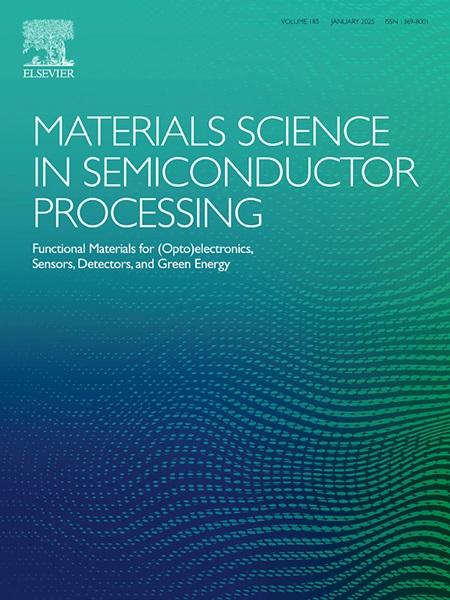Multiple-step Siconi pre-clean advantages for Ni(Pt)Si film formation in the frame of advanced FDSOI technology development
IF 4.2
3区 工程技术
Q2 ENGINEERING, ELECTRICAL & ELECTRONIC
引用次数: 0
Abstract
In the development of 28 nm Fully Depleted Silicon On Insulator (FDSOI) technology utilizing high-k metal gate transistors, Ni-based silicide contacts are essential for active silicon regions. The integration of metal gate transistors with the Ni(Pt)Si formation process presents significant challenges, particularly regarding surface preparation prior to Ni (10 at.% Pt) deposition. This step is critical as it can facilitate the propagation of Sulfuric Peroxide Mixture (SPM) chemistry during Ni(Pt)Si formation, potentially leading to the removal of the TiN layer within transistor gates, commonly referred to as "black gates”. To address these challenges, various NF3/NH3 dry pre-clean processes, known as the Siconi process, have been explored to enhance Ni(Pt)Si thin film formation at reduced dimensions without compromising the integrity of high-k metal gate structures. Notably, a multi-step Siconi process has significantly reduced non-uniformity issues of the Ni(Pt)Si thickness on blanket wafers. Additionally, a distinct distribution of fluorine species is observed at the interface between the intermixing layer and the silicon substrate, with potential new bond formations identified in multi-step processes. Furthermore, substantial improvements in silicide resistance and SRAM yield have been recorded, attributed to the reduction of "missing NiSi" and "black gates" defects through the implementation of this novel surface preparation approach.
在先进FDSOI技术发展的框架下,多步Siconi预清洁对Ni(Pt)Si薄膜形成的优势
在利用高k金属栅极晶体管开发28 nm完全耗尽绝缘体上硅(FDSOI)技术的过程中,ni基硅化触点是活性硅区域必不可少的。金属栅极晶体管与Ni(Pt)Si形成过程的集成提出了重大挑战,特别是在Ni(10at)之前的表面制备方面。% Pt)沉积。这一步是至关重要的,因为它可以促进Ni(Pt)Si形成过程中硫酸过氧化物混合物(SPM)化学的传播,可能导致晶体管栅极内TiN层的去除,通常被称为“黑栅极”。为了应对这些挑战,人们探索了各种NF3/NH3干燥预清洁工艺,即Siconi工艺,以在不影响高k金属栅极结构完整性的情况下,在降低尺寸的情况下增强Ni(Pt)Si薄膜的形成。值得注意的是,多步Siconi工艺显著降低了毡片上Ni(Pt)Si厚度的不均匀性问题。此外,在混合层和硅衬底之间的界面处观察到氟物种的明显分布,并在多步骤过程中确定了潜在的新键形成。此外,由于通过实施这种新的表面制备方法减少了“缺失的NiSi”和“黑门”缺陷,硅化电阻和SRAM产量也有了实质性的改善。
本文章由计算机程序翻译,如有差异,请以英文原文为准。
求助全文
约1分钟内获得全文
求助全文
来源期刊

Materials Science in Semiconductor Processing
工程技术-材料科学:综合
CiteScore
8.00
自引率
4.90%
发文量
780
审稿时长
42 days
期刊介绍:
Materials Science in Semiconductor Processing provides a unique forum for the discussion of novel processing, applications and theoretical studies of functional materials and devices for (opto)electronics, sensors, detectors, biotechnology and green energy.
Each issue will aim to provide a snapshot of current insights, new achievements, breakthroughs and future trends in such diverse fields as microelectronics, energy conversion and storage, communications, biotechnology, (photo)catalysis, nano- and thin-film technology, hybrid and composite materials, chemical processing, vapor-phase deposition, device fabrication, and modelling, which are the backbone of advanced semiconductor processing and applications.
Coverage will include: advanced lithography for submicron devices; etching and related topics; ion implantation; damage evolution and related issues; plasma and thermal CVD; rapid thermal processing; advanced metallization and interconnect schemes; thin dielectric layers, oxidation; sol-gel processing; chemical bath and (electro)chemical deposition; compound semiconductor processing; new non-oxide materials and their applications; (macro)molecular and hybrid materials; molecular dynamics, ab-initio methods, Monte Carlo, etc.; new materials and processes for discrete and integrated circuits; magnetic materials and spintronics; heterostructures and quantum devices; engineering of the electrical and optical properties of semiconductors; crystal growth mechanisms; reliability, defect density, intrinsic impurities and defects.
 求助内容:
求助内容: 应助结果提醒方式:
应助结果提醒方式:


